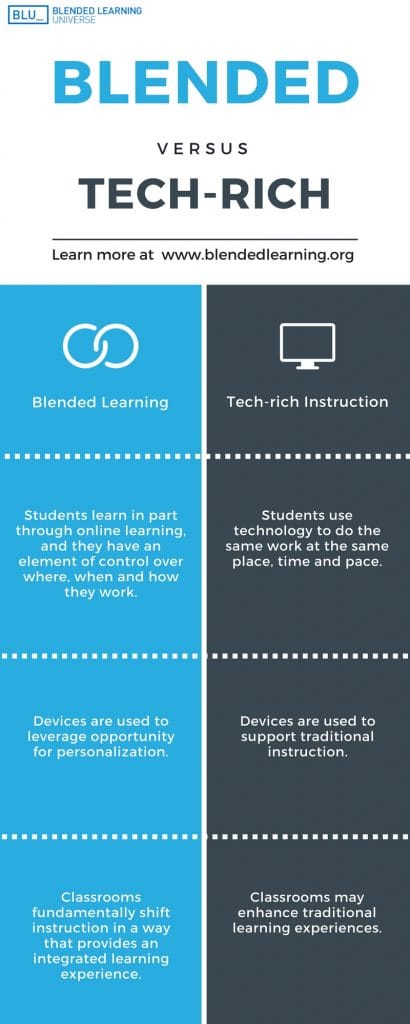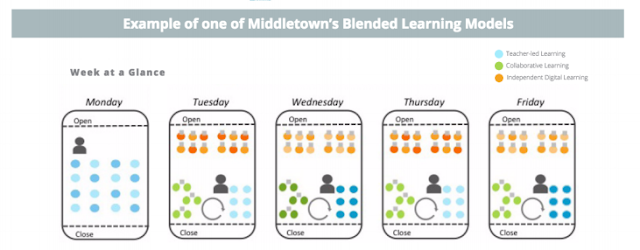My Reflection Over Blended Learning
I wanted to share some of my thoughts with you.
Last month, I attended a panel at an education conference where the moderator asked a group of panelists, “How do you define blended learning?” The moderator’s question came from a realistic vantage point: with a wide range of educational terms, including project-based learning, blended learning, personalized learning, and online learning, it can be difficult to differentiate what blended learning is and isn’t. Nevertheless, I felt frustrated by her question because it assumed that each panelist would have different insights to offer on what blended learning means. Without a universal definition of blended learning there is no shared language by which the education field can describe the phenomena or address its opportunities and challenges.
The phenomenon of blended learning has its roots in online learning and represents a fundamental shift in instruction that has the potential to optimize for the individual student in ways that traditional instruction never could. Although schools have been using computers and technology for some time, until recently they haven’t generally used technology to provide students with a true “blend” of instruction that gives them some element of control over their learning. The definition of blended learning has three parts, described below:

1. In part through online learning
First, blended learning is any formal education program in which a student learns at least in part through online learning, with some element of student control over time, place, path, and/or pace.
Critical to the definition is “online learning, with some element of student control.” In all blended-learning programs, students do some of their learning via the Internet. This does not mean using any digital tool, such as an online graphing calculator or Google Docs. Online learning means a bigger instructional shift from a face-to-face teacher to web-based content and instruction.
Some element of student control is critical; otherwise, blended learning is no different from a teacher beaming online curriculum to a classroom of students through an electronic whiteboard. The technology used for the online learning must shift content and instruction to the control of the student in at least some way for it to qualify as blended learning from the student’s perspective, rather than just the use of digital tools from the classroom teacher’s perspective. It may be merely control of pace—the ability for students to pause, go back, or skip forward through online content as free agents. But often, online learning extends other types of control—in some cases students can choose the time at which they do their online learning, the path they want to take to learn a concept, or even the location from which they want to complete the online work—whether in a brick-and-mortar classroom or anywhere else.
2. In part in a supervised brick-and-mortar location
The second part of the definition is that the student learns at least in part in a supervised brick-and-mortar location away from home. In other words, the student attends a physical school with teachers or guides. Often it’s the neighborhood school, but in other cases it’s a learning center that could even be housed in a shopping mall space that has been converted into a drop-in computer lab. Blended learning means that students have at least some on-campus, away-from-home component built into their schedule.
3. An integrated learning experience
The third part of the definition is that the modalities along each student’s learning path within a course or subject are connected to provide an integrated learning experience. The opposite of this would be that the students learn some topics online and then return to their traditional classroom to repeat them in a face-to-face lecture. To prevent such lack of coordination, most blended-learning programs use a computer-based data system to track each student’s progress and try to match the modality—whether it is online, one-on-one, or small group—to the appropriate level and topic. The key idea is that blended learning involves an actual “blend” of whatever formats are within the course of study.
By understanding blended learning as an instructional delivery model that gives students some element of control over their learning and by leveraging the opportunity of personalization that blended learning can provide at scale, educators can start to address challenges and opportunities in their schools that will enable them to move the practice of blended learning forward.
This is my last post on types of learning styles – next time, I will wrap everything up and give some overall ideas and guidelines for using this information!
Thank You to my lecturer, friends and family...

Comments
Post a Comment